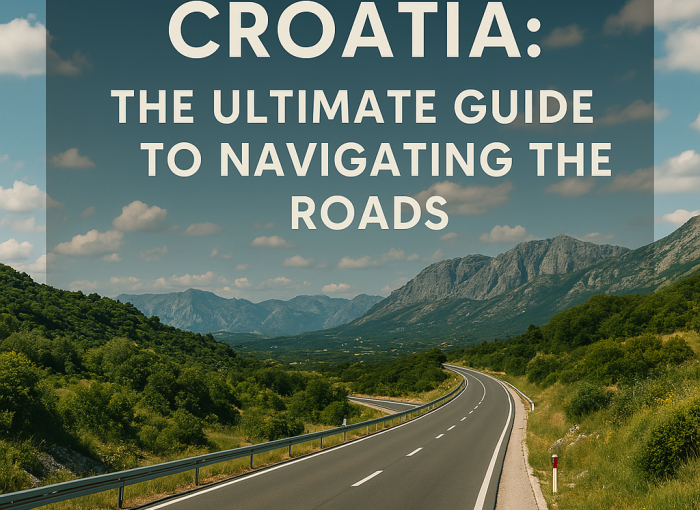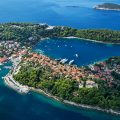Discover Croatia like never before! Our ultimate guide to navigating the roads will lead you through stunning landscapes, charming towns, and hidden gems.
Table of Contents
Croatia, with its captivating Adriatic coastline, charming towns, and rich historical heritage, presents an alluring destination for travellers. One of the most exhilarating ways to experience this vibrant nation is by hitting the road. Whether meandering through ancient cities or cruising along the Adriatic Sea, driving offers unparalleled freedom and flexibility. This guide provides invaluable insights into the nuances of the Croatian road network, making your journey not only seamless but also memorable.
Embarking on a road trip in Croatia promises an adventure filled with diverse landscapes and cultural landmarks. From the vibrant streets of Zagreb to the serene beaches of Dubrovnik, the country is a treasure trove of sights waiting to be discovered. Driving allows one to venture beyond the traditional tourist trails and explore hidden gems tucked away in the countryside. As you plan your trip, understanding the nation’s road structure will be crucial for a rewarding experience.
Navigating Croatia’s roads requires some preparation, but the effort is well worth it. This guide will cover everything from highway costs to scenic routes, ensuring you are well-equipped to handle any challenges on the road. Whether you are renting a car for a short holiday or embarking on an extended travel expedition, this comprehensive overview will help you embrace the journey with confidence.
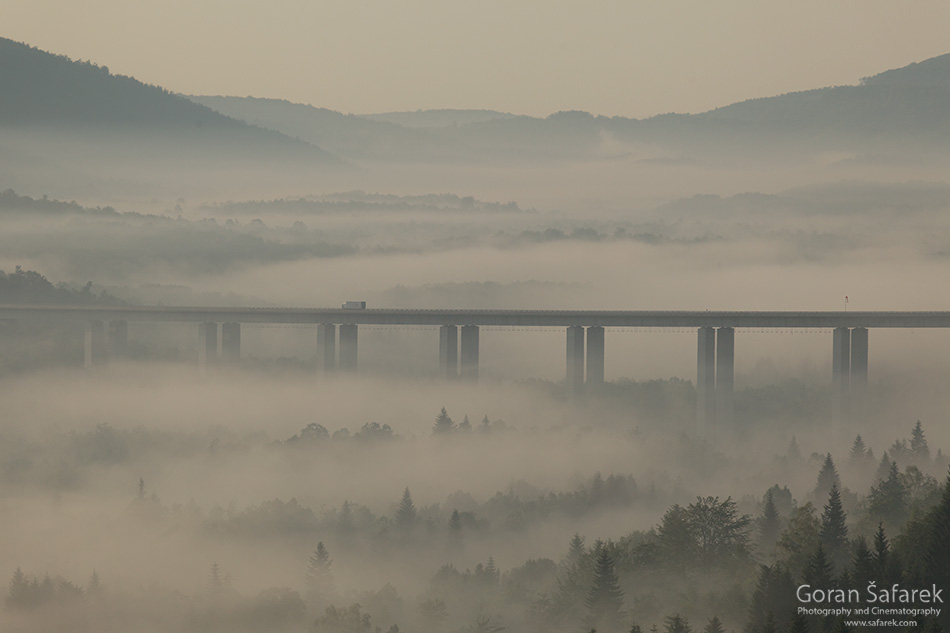
Overview of Croatia’s Road Network
Croatia’s road network is a well-maintained system connecting urban centres with rural areas, facilitating smooth travel across the country. The network comprises various road types, including highways, national roads, and local routes, each offering distinct experiences. Understanding these options will enable travellers to make informed decisions based on their itinerary and preferences.
Highways: Expensive and Fast
Croatia’s highways, known as “autoceste,” are modern and efficient, designed for quick travel between major cities. These roads are toll-based, so travellers should be prepared for additional expenses. However, the convenience and time saved are often worth the cost, especially for those on tight schedules. Toll booths are stationed at various points, and payments can be made in cash or by card.
A critical feature of Croatian highways is their extensive tunnel system, which ensures a smooth journey through the country’s mountainous terrains. These tunnels, coupled with well-marked exits and service areas, make highways an attractive option for long-distance travel. While the speed limits are typically higher on these roads (max 130km/h), travellers should remain vigilant and adhere to regulations to ensure safety.
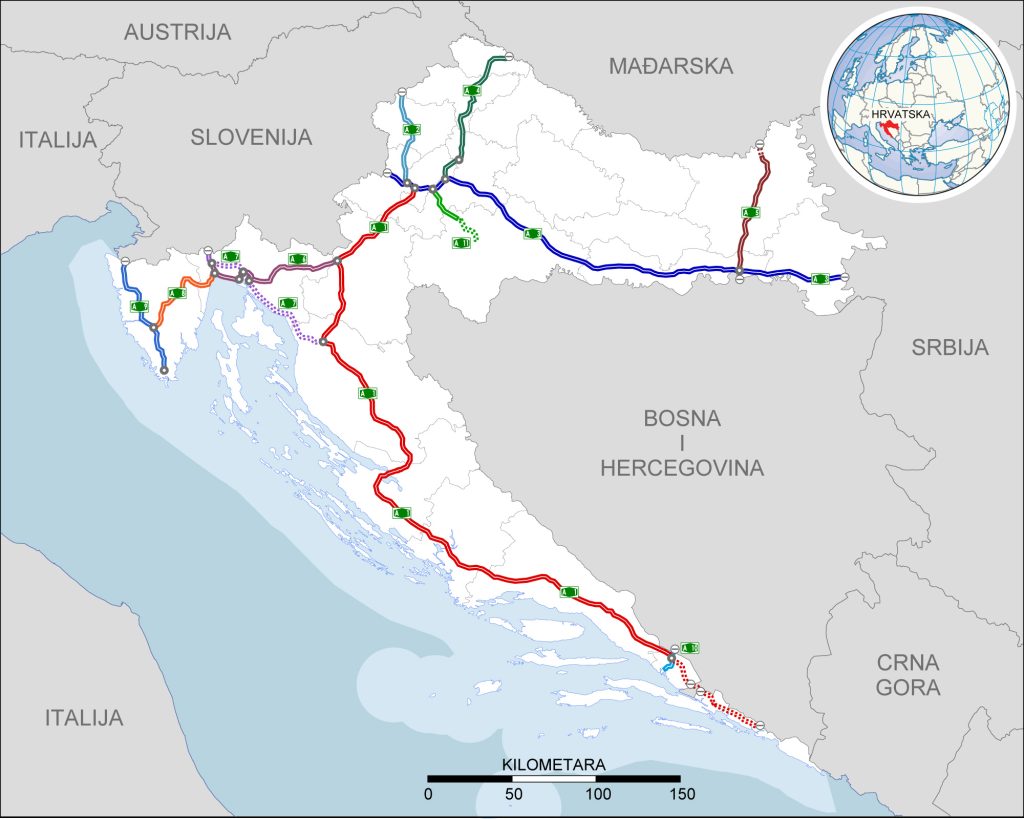
Croatian highways can be quite pricey, and since there’s no vignette system, you’ll need to pay for each section you drive through.Costs can add up, especially for long trips (e.g., Zagreb to Split can be €20+).
Despite the costs, highways offer a straightforward path for those looking to maximise their travel time. They connect major cities like Zagreb, Split, and Rijeka, providing a direct route to numerous attractions. For those prioritising efficiency and speed, highways are an ideal choice, though they may lack the scenic allure of other road types.
On Croatian highways, the average price per kilometer for passenger vehicles is approximately €0.07 to €0.09 EUR/km, depending on the specific section and whether you’re traveling through tunnels or bridges (which may have slightly higher rates).
🧾 Example (2024–2025 prices):
- Zagreb to Split (approx. 410 km): around €28 in tolls
- Zagreb to Rijeka (approx. 160 km): around €10.50
This means a general average of:
- €7–€9 per 100 km for a car (Category I)
Keep in mind:
- Tolls are collected at booths (not a vignette system like in Slovenia or Austria).
- Prices are higher for vans or vehicles with trailers (Category II and up).
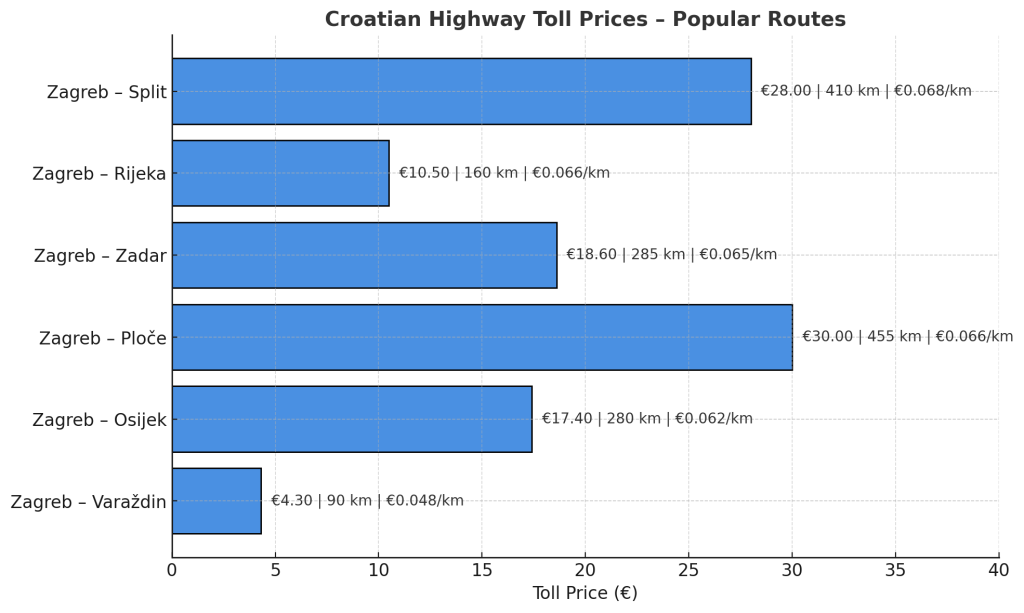
National and Local Roads: Slow but Scenic
Contrasting the efficiency of highways, Croatia’s national and local roads offer a more leisurely and picturesque driving experience. These roads often wind through charming villages, lush forests, and along the stunning Dalmatian coast, presenting travellers with an opportunity to immerse themselves in the country’s natural beauty. While these routes might take longer, the journey itself becomes a rewarding part of the adventure.
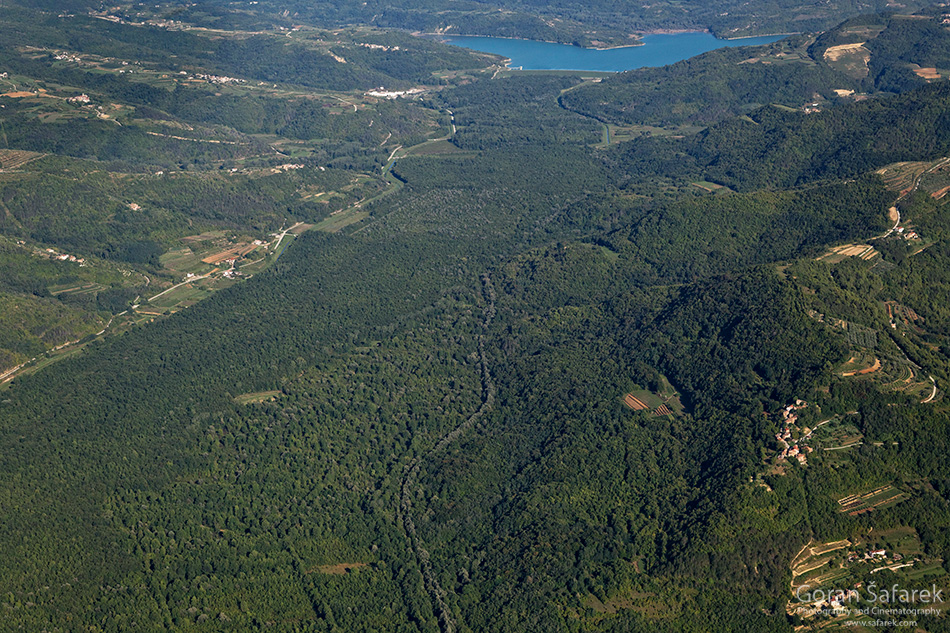
National roads, or “državne ceste,” connect smaller towns and can serve as an alternative to toll highways. They provide a more intimate view of Croatia’s diverse landscapes and cultural heritage. Local roads, or “lokalne ceste,” are even more off-the-beaten-path, perfect for those looking to explore Croatia’s hidden corners. However, drivers should be prepared for narrower paths and occasional rough patches.
Travelling on national and local roads allows for spontaneous stops and discoveries, such as quaint restaurants offering authentic Croatian cuisine or historical sites that aren’t listed in mainstream travel guides. For those who value the journey as much as the destination, these routes offer a quintessential Croatian experience.
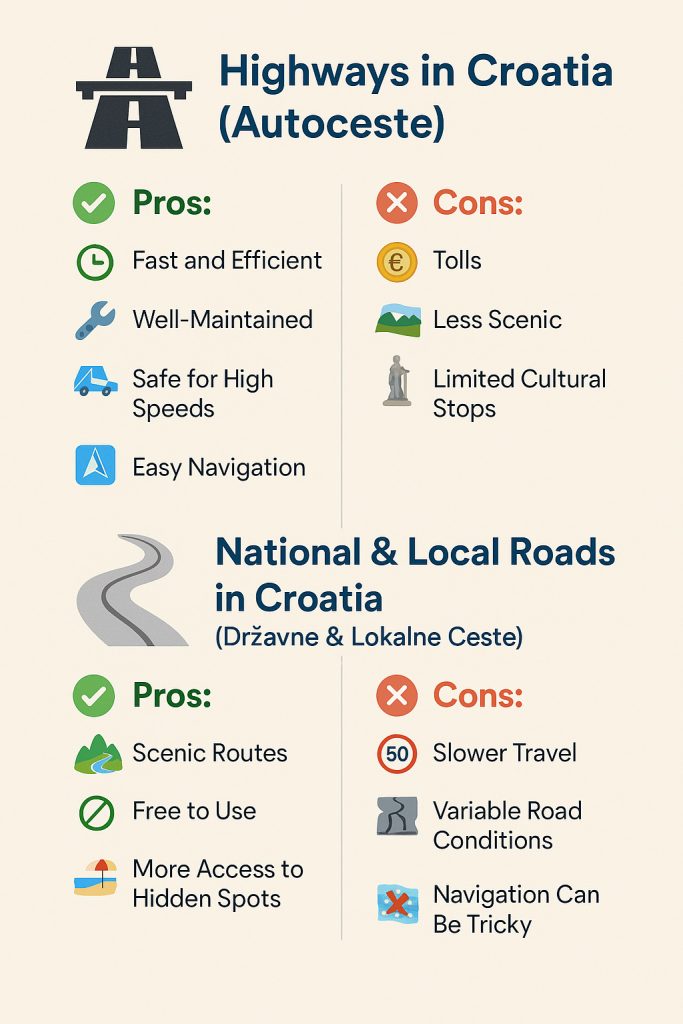
Essential Tips for Driving in Croatia
Driving in Croatia can be an enjoyable experience if approached with the right knowledge and preparation. Understanding local driving customs and regulations is essential for a smooth journey. Here are some vital tips to ensure you are ready for the road ahead.
Familiarise yourself with Croatian road signs and signals, as they may differ from those in your home country. Most signs are international, but it’s beneficial to learn a few Croatian terms for added clarity. Adhering to speed limits is crucial, as speed cameras are widespread, and fines can be hefty. The speed limit is generally 130 km/h on highways, 90 km/h on open roads, and 50 km/h in urban areas.
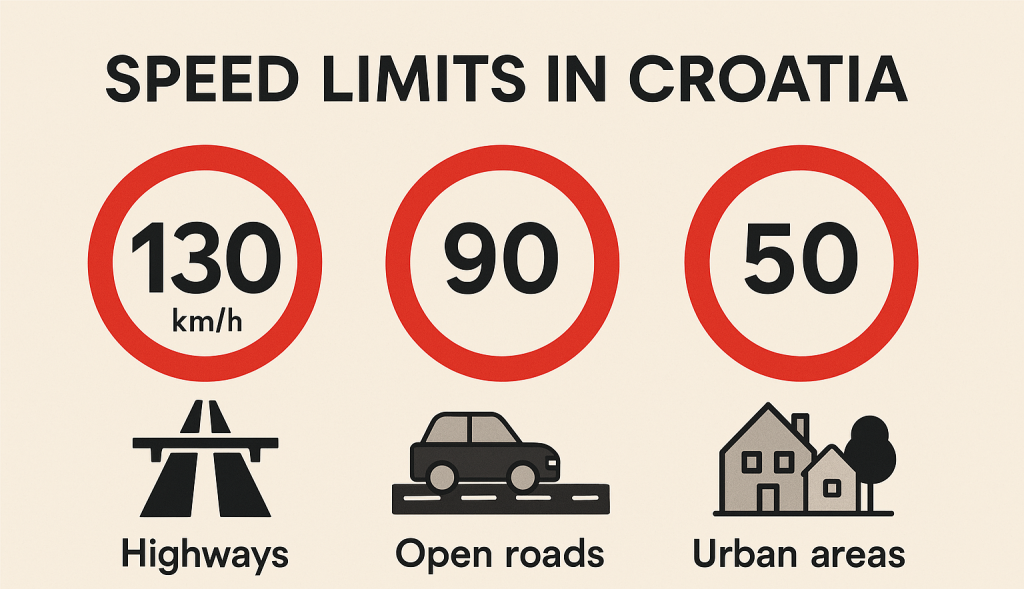
It’s advisable to have a reliable GPS or mobile navigation app to assist with directions, especially when exploring remote regions. Mobile coverage is generally good, but it’s wise to download maps for offline use as a precaution. Additionally, ensure your vehicle is equipped with essential items such as a reflective vest, warning triangle, and spare tyre, as these are mandatory by law.

While driving, keep an eye out for wildlife, especially in rural areas where animals may unexpectedly cross the road. Also, consider the weather conditions; Croatia’s climate can vary significantly from coastal to inland regions. Being prepared for sudden changes in weather, particularly during winter months, can make a significant difference in your driving experience.
Gas Stations in Croatia
Gas stations are easy to find across Croatia, including major highways, cities, and even rural areas. Brands like INA, Petrol, and Crodux are the most common, and most stations accept credit cards.
💡 Tip: Fuel is more expensive on highways than on local roads or in towns—sometimes by as much as €0.10–€0.20 per liter. If you’re not in a rush, it’s worth exiting the highway to refuel at a local station and save some euros!
Mind the Parking Zones
Cities like Zagreb, Split, and Dubrovnik have color-coded parking zones:
- Red = expensive/short stay
- Yellow = medium
- Green = cheaper/longer
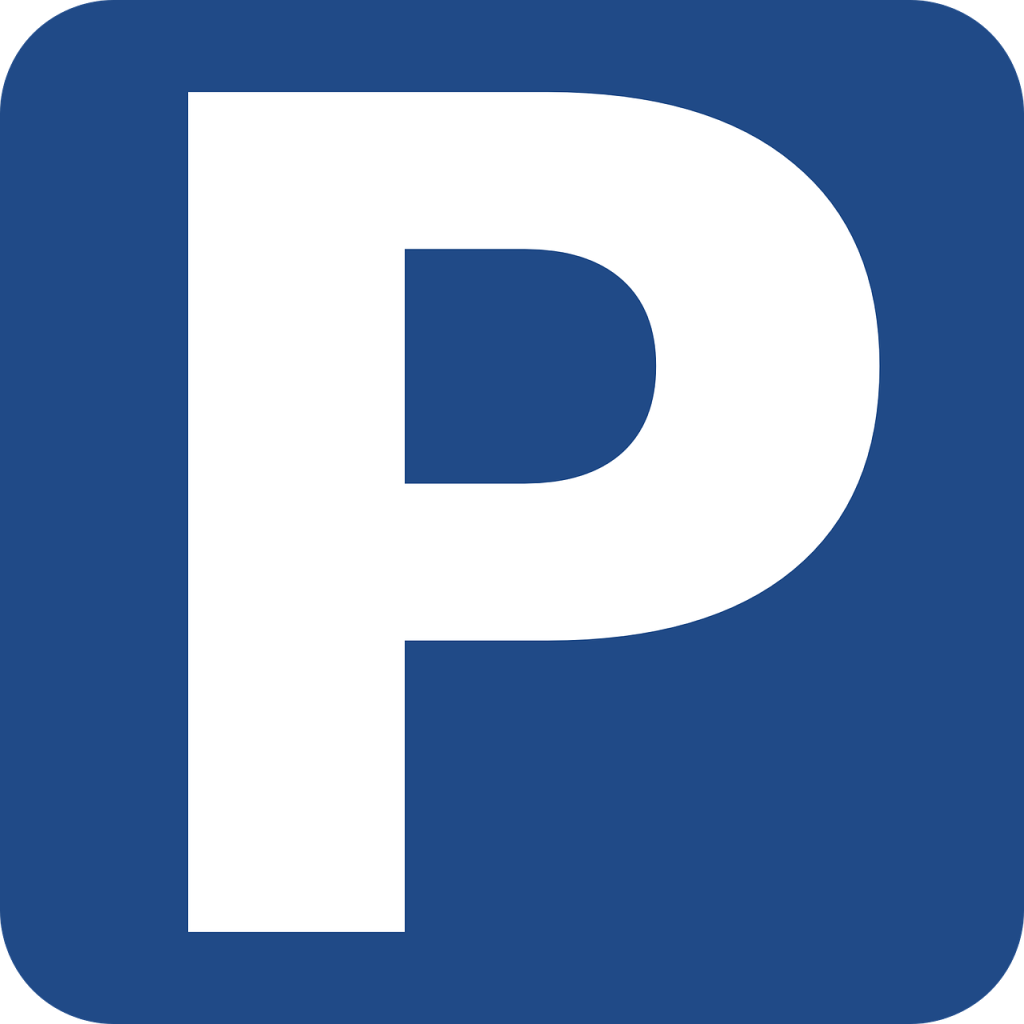
Always pay at the meter or via SMS; fines are common and quick.
Car Rental Options for Your Holiday in Croatia
Renting a car in Croatia is a convenient and flexible way to explore the country at your own pace. There are numerous car rental agencies, ranging from international companies to local providers, offering a variety of vehicles to suit different needs and budgets. Here are some key considerations when renting a car for your Croatian holiday.
💰 Average Costs (2024–2025):
| Season | Economy Car (per day) | SUV/Automatic (per day) |
|---|---|---|
| 🏖 Summer (June–Sept) | €45–€90 | €80–€150+ |
| 🍂 Off-season (Oct–May) | €20–€40 | €40–€80 |
📈 Factors That Affect Rental Prices:
- 📅 Seasonality: July and August see the highest prices due to peak tourist demand.
- 📍 Pickup Location: Rentals from airports (Zagreb, Split, Dubrovnik) often cost more than city offices.
- 🚗 Car Type: Automatics are pricier than manuals, and SUVs/minivans are in high demand for families.
- 🛡 Insurance Add-ons: Full coverage (with zero excess) can add €10–€25/day.
- 🧳 One-way Fee: Picking up and dropping off in different cities adds extra (€50–€100+).
- ⛽ Fuel Policy: Full-to-full is common, but always double-check to avoid surprise charges.
💡 Tips to Save:
- Book early (especially for summer).
- Use local agencies — they’re often cheaper than international chains.
- Check for hidden fees like extra driver charges, border-crossing fees, or out-of-hours pickup.
- Bring your own child seat/GPS to avoid pricey rentals.
- Use credit cards with CDW insurance to skip buying expensive coverage.
Planning for Cross-Border Travel
If you plan to drive beyond Croatia’s borders, inform the rental company in advance, as some vehicles may not be permitted to leave the country. There may be additional fees for cross-border travel, and it’s crucial to ensure your rental agreement includes the necessary insurance coverage. Popular cross-border destinations include Slovenia, Bosnia and Herzegovina, and Montenegro, each offering unique attractions worth exploring.
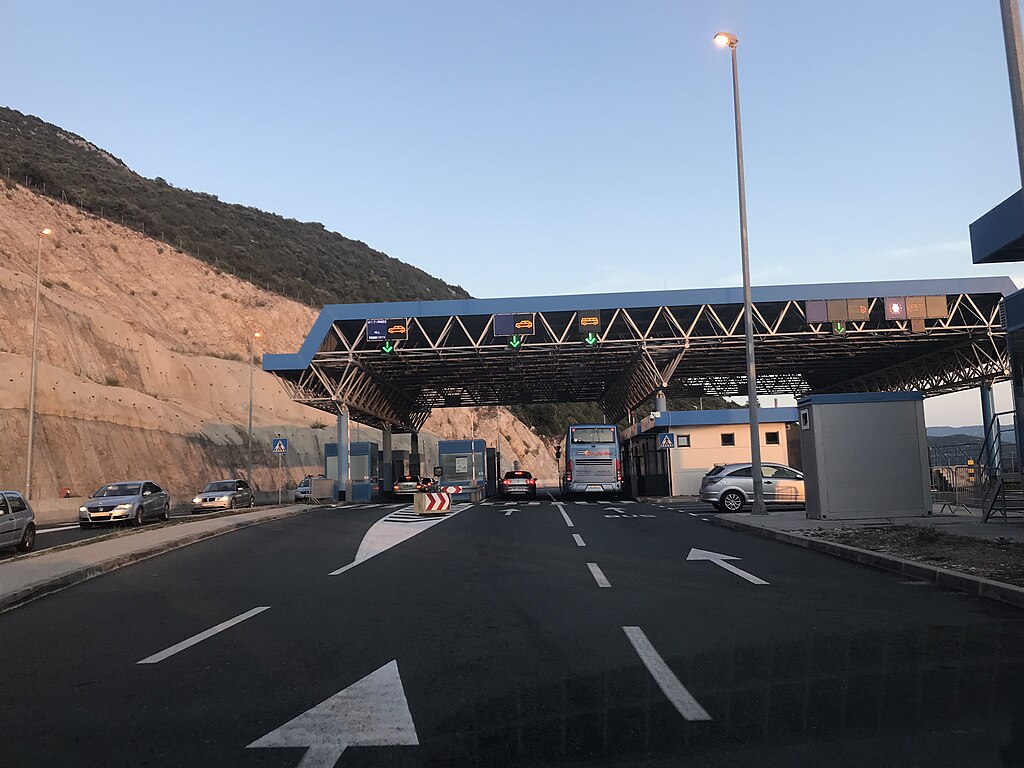
Safety and Regulations for Driving in Croatia
Safety is paramount when driving in a foreign country, and Croatia is no exception. Familiarising yourself with local regulations and practices will ensure a safe and enjoyable journey. Here are some important safety guidelines and regulations to keep in mind.
Adhering to Traffic Laws
Croatia has strict traffic laws, and adherence is crucial for your safety and that of others. Seat belts are mandatory for all passengers, and using a mobile phone while driving is prohibited unless you have a hands-free device. The legal blood alcohol limit is lower than in some countries, at 0.05% for most drivers and 0.00% for professional and novice drivers. Always drive sober to avoid penalties and ensure your safety.
In Croatia, speeding fines vary depending on how much you exceed the speed limit and whether you’re in an urban or non-urban area. Police tolerance and enforcement are strict, especially on highways and near urban zones with cameras.
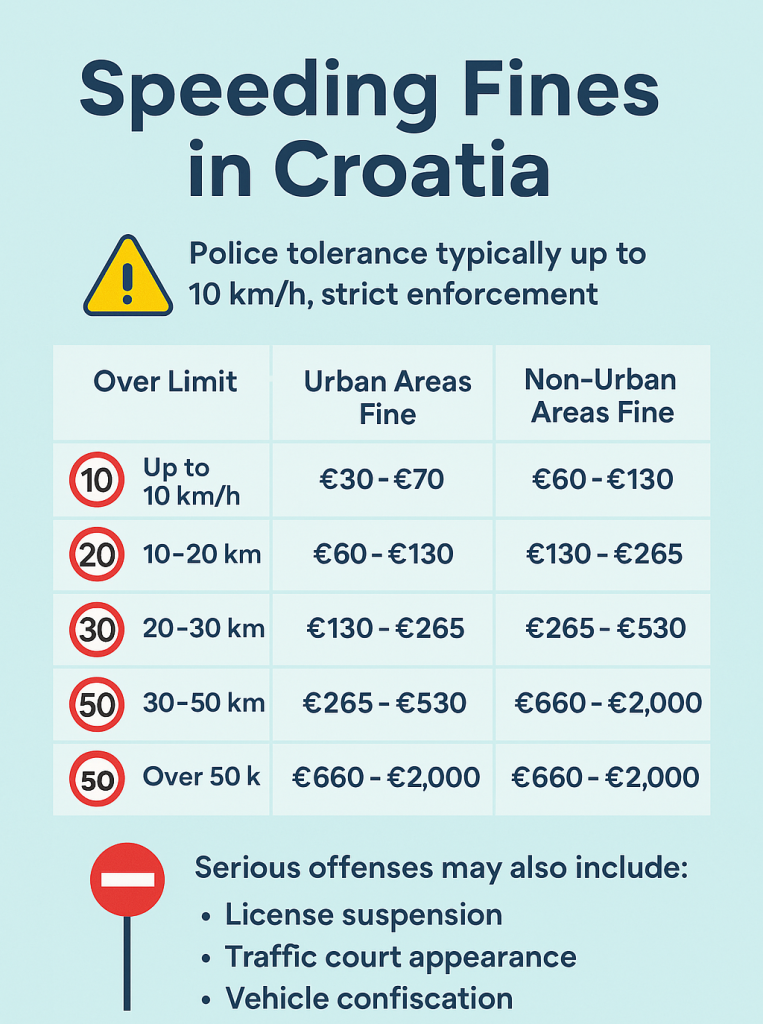
🚓 Police Tolerance (Speed Buffer)
- A general tolerance of 10 km/h is applied for speeds under 100 km/h.
- For speeds over 100 km/h, a 10% tolerance is typically applied.
Example:
If the limit is 90 km/h, you won’t usually get fined until you exceed 100 km/h.
If the limit is 130 km/h, you may have leeway up to around 143 km/h.
🚫 Serious Offenses May Also Include:
- License suspension (commonly 1–3 months for 50+ km/h over limit)
- Traffic court appearance
- Vehicle confiscation (in extreme, repeated violations)
Road Cameras in Croatia: What You Should Know
In recent years, Croatia has significantly ramped up the number of speed cameras and traffic surveillance systems across the country. You’ll find these particularly on major highways, around city entrances, and in zones with frequent speed limit changes. This increase in road cameras comes with a noticeable decrease in old-school police ambushes (you know, the ones hiding behind bushes with radar guns). That said, random roadside police checks still happen, especially in smaller towns (especially Karlovac-Plitvice road) and during holiday weekends—so don’t relax too much!
These fixed cameras are mostly automated and linked to a central system that logs your plate and mails you a ticket if you’re speeding—yes, even if you’re driving a rental car. The fine usually finds its way to you, one way or another.
If you’re planning a road trip and want to avoid nasty surprises, a few handy real-time apps can keep you in the know:
🛑 Top Apps to Track Road Cameras in Croatia
- Waze – Super popular among locals and tourists alike, this community-driven app alerts you to speed cameras, traffic jams, police presence, and even potholes. It’s basically your best co-pilot in Croatia.
- Radarbot – Focused on detecting fixed and mobile speed cameras, this app works even offline and updates regularly with new camera data.
- CamSam – Offers real-time alerts for speed traps and red-light cameras, and has a solid database for Croatian roads.
- Google Maps – While not as detailed as Waze in terms of alerts, it does show some speed camera locations and will warn you while navigating.
- Trapster (if still available in your region) – Used to be a go-to app for live user-submitted camera locations, though support varies now.
Local tip: Croatian drivers tend to flash their headlights to warn others of upcoming cameras or police checks. If someone flashes at you on a calm stretch of road, it’s usually not just a friendly hello—slow down!
So while high-tech surveillance is replacing the old-school traps, staying alert (and using the right apps) is still your best bet for a fine-free drive through this gorgeous country.
Handling Emergencies on the Road
In the event of an emergency, such as a breakdown or accident, it’s important to remain calm and follow proper procedures. Contact the local police and your rental company for assistance. The emergency number in Croatia is 112, which connects you to all emergency services. Having a basic first-aid kit and emergency contact information readily available can be invaluable in such situations.
How to Avoid Traffic Jams in Croatia During Summer
If you’re planning a road trip through Croatia in July or August, avoiding the notorious summer traffic can make all the difference in your travel experience. The busiest days on the roads are weekends—especially Saturdays, which are changeover days for many holiday rentals. If you can, try to schedule your drives midweek, from Tuesday to Thursday, when the roads are noticeably less congested.
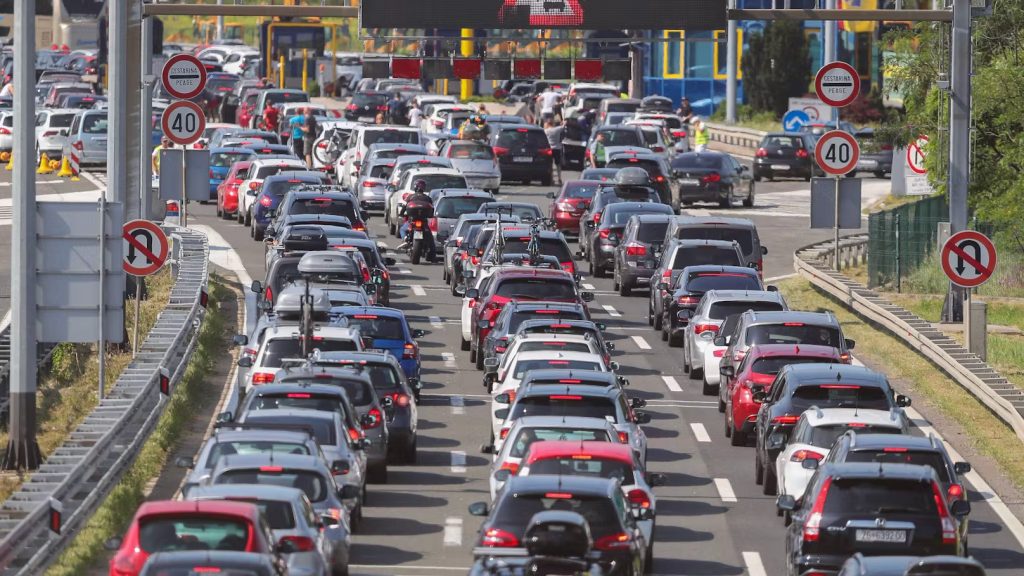
Another helpful tip is to drive early in the morning or later in the evening. Croatian roads are much quieter after 8 PM and before 9 AM, and driving during these cooler hours can also be more pleasant, especially in the heat of summer.
When traffic builds up on the main highways (autoceste), consider taking the scenic route instead. State roads like the D1 and D8 often offer less traffic, gorgeous views, and more local experiences. Navigation apps like Google Maps or Waze are great tools to help you find real-time detours and traffic-free routes.
It’s also a good idea to plan your rest stops outside of peak lunch hours, as toll booths and service stations can get overwhelmed around midday. Grabbing a break earlier or later can help you avoid long queues and get back on the road faster.
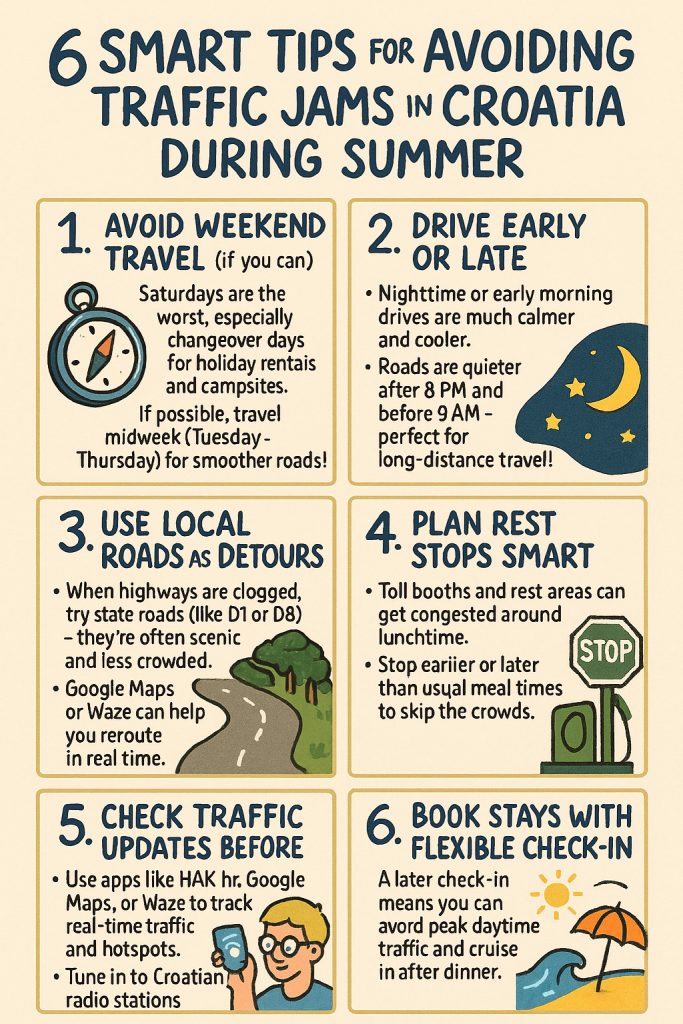
Before setting out, always check live traffic updates. The Croatian Auto Club website (HAK), Google Maps, and Waze offer accurate, up-to-the-minute information. For local insight, tune in to radio stations like HR2, which broadcast summer traffic news in multiple languages.
Lastly, consider booking accommodations with flexible check-in times. That way, you won’t feel rushed to beat the traffic and can enjoy a more relaxed, scenic drive—even if it means arriving later in the evening.
Conclusion: Embracing the Freedom of the Open Road in Croatia
Exploring Croatia by road is a journey of discovery, offering a unique blend of adventure, culture, and natural beauty. From the bustling streets of Zagreb to the tranquil shores of the Adriatic, the country’s diverse landscapes beckon travellers to explore at their own pace. With the right preparation and knowledge, you can navigate Croatia’s roads with confidence, uncovering hidden treasures along the way.
Driving in Croatia provides the flexibility to tailor your itinerary, allowing for spontaneous detours and memorable encounters. Whether you’re embarking on a coastal drive, exploring quaint villages, or immersing yourself in the stunning national parks, the open road promises endless possibilities. As you plan your Croatian adventure, embrace the freedom that comes with a self-guided road trip, and let the journey shape your experience.
For those ready to embark on this thrilling road adventure, start planning your itinerary today. Research car rental options, familiarise yourself with road regulations, and prepare for an unforgettable exploration of Croatia’s captivating landscapes. The road awaits, promising new experiences and breathtaking views at every turn.
